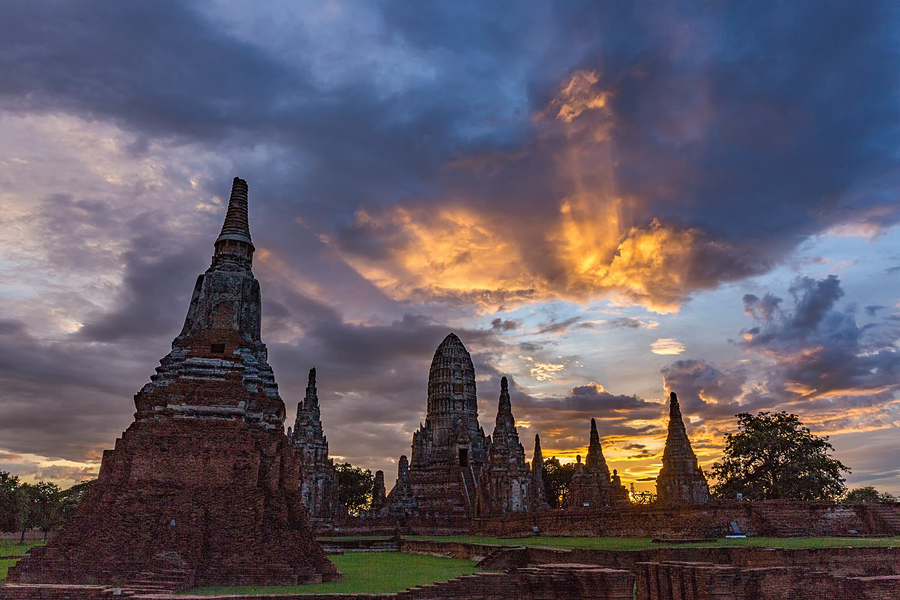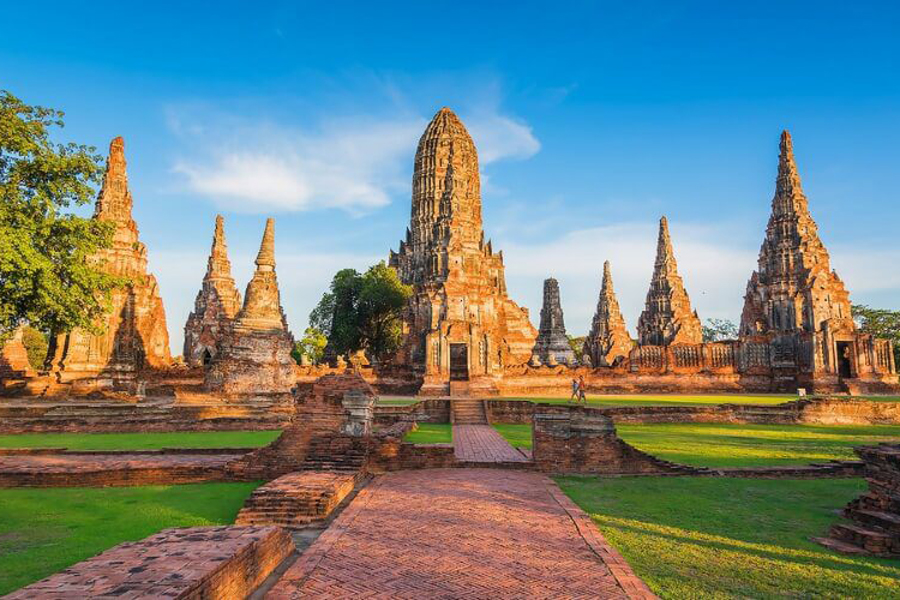Ayutthaya

Ayutthaya province was once the powerful capital of the Siamese Kingdom from 1350 until 1767. It's located in central Thailand, and it's a truly special place. Today, the city's ancient ruins and magnificent temples stand as a testament to its glorious past, welcoming visitors from all over the globe.
This UNESCO World Heritage Site is an incredible blend of Khmer and Siamese styles, showcasing the strategic location where cultural influences converge. Let your imagination soar as you explore the city's structures, from grand stupas to crumbling monasteries and intricately carved Buddha statues that have stood the test of time.
.jpg)
Ayutthaya - the ancient capital of Thailand
The history of Ayutthaya goes back to the late 13th century when it first emerged as a prosperous trading centre on the Chao Phraya River. Thanks to its great location—rich lands and easy access to water transport—Ayutthaya grew and, in time, became the capital of the Siamese Kingdom in 1351.
It was a modern centre of arts, literature, and architecture during this golden era of the kingdom, and various palaces, temples, and monasteries were built in the style recognised as Ayutthaya. Thousands of grand but artistic structures result from the Ayutthaya style of construction. The equally famous, much-advanced irrigation system supported the country's rich agricultural economy.

Visit the ruined city of Ayutthaya and feel the atmosphere of Thai history
From the 18th century onward, however, Ayutthaya began a downward spiral. The internal struggle for power and pressure from neighbouring powers, such as Burma, led to a third and final decline. In 1767, the Burmese army launched a long and ferocious siege against Ayutthaya, sacking and burning down this ancient city. Since then, the four-centuries-long glory of the kingdom had come to an end.
You may also like: How to get to Koh Phi Phi from Krabi?
Ayutthaya has a tropical climate and includes three obvious seasons: one hot, one rainy, and one cool.
From many angles, the cool season from November to February next year may turn out to be the best visiting time for Ayutthaya. During these months, the temperatures come down to a very likeable 25°C to 32°C and the precipitation remains very low. However, there is an extremely large arrival of tourists, so prices for accommodation and activities go up accordingly.

Explore the peaceful and ancient capital of Thailand
Only 76 kilometres north of Bangkok, Ayutthaya is easily reachable by day trip from the Thai capital. These vary in price and preference, serving a few different ways to get to this historical city.
By far the fastest and most convenient way to get from Bangkok to Ayutthaya is by train. There are plenty of trains leaving from Bangkok's Hua Lamphong station, and the journey takes about one and a half hours. Trains are a great, affordable way to see the Thai countryside.
You can drive or take a taxi from Bangkok to Ayutthaya if you want more freedom. Depending on traffic, it takes about 1–1.5 hours. You may also consider renting a car to see Ayutthaya at your own pace and visit other places nearby.

Explore Ayutthaya Historical Park
Right in the middle of the Ayutthaya ruins, Wat Chaiwatthanaram stands tall and proud as a reminder of the mighty kingdom that once was. The way nature has invaded its intricate details gives it the unassuming quality that no tourist could miss. The central prang is the tallest and has a bud lotus flower shape, which makes it the most prominent feature in the landscape. Four other small prangs represent the four faces of Buddha, symbolising his omnipresence.
You'll be blown away by all the intricate carvings and the peaceful atmosphere as you explore the temple complex. And don't miss the prang for the amazing views of the ruins and the Chao Phraya River. Wat Chaiwatthanaram is the perfect place to immerse yourself in the rich history and spiritual significance of Ayutthaya.

Wat Chaiwatthanaram (Credit: G2nfreeb)
Wat Mahathat is on the UNESCO World Heritage list, so it's a great place to visit in Ayutthaya. This is one of those old temple complexes where you can see the magnificent glory and grandeur of the former Siamese capital.
The first thing that springs to mind is the Buddha's head embedded in the roots of a banyan tree, a reminder that time passes and faith endures. You'll walk around towering stupas, intricate carvings, and the remains of these grand buildings. Make sure you don't miss out on the chance to climb the central prang and enjoy the amazing views over the temple and surrounding area.

Wat Mahathat (Credit: World Heritage Journey)
A visit to the Ayutthaya Historical Park, a UNESCO World Heritage Site, will give an insight into the heart of Thai history. The vast complex that once used to be the vibrant capital of the Siamese Kingdom speaks volumes about how great a nation Thailand is and how rich its culture is.
The old royal temple of Wat Phra Sri Sanphet is one of the most well-known sights in the park. Mute sentinels, the three tall chedis that once wore a cloak of gold, stand guard over the memory of Ayutthaya's former glory. Another place you shouldn't miss is Wat Yai Chai Mongkol, famous for its huge prang and the Buddha statue with the same name, which has some pretty amazing powers.

Ayutthaya Historical Park (Credit: Adobe)
Besides these two famous temples, there are lots more historical treasures to be explored at Ayutthaya Historical Park. One can take a walk along the ruins of the ancient city walls, appreciate the fine details of the Buddha head casement in a banyan tree at Wat Mahathat, or simply relax and savour the serenity of the peaceful surroundings.
From a lowly hostel to a five-star resort, there is a great choice of places to stay in Ayutthaya to suit all budgets and tastes. If you like a bit of luxury, the city is home to a good selection of high-class hotels and resorts, many of which line the banks of the Chao Phraya River, offering stunning views and easy access to historic sites.
Otherwise, there are plenty of reasonable guesthouses and hostels available in Ayutthaya, especially around the train station and main markets. They generally offer simple but clean rooms with shared bathrooms and a friendly atmosphere.

Hotel in Ayutthaya (Credit: Tripadvisor)
The food in Ayutthaya is a real treat. It was a good mix of Thai flavours and the rich history that this city had been having for so long, being the capital city. Some of the top-ranking dishes here use fresh produce and ingredients, while flavour profiles are really robust, with beautiful aromas bringing out the spices.
Ayutthaya's Kuay Tiau should satisfy those in search of a bowl full of goodness: tender beef or pork, some crispy fried pork cracklings, a sprinkle of fresh herbs, and rich soul-warming broth.

Kuay Tiau (Credit: Food Network)
For something different, try the Khao Mun Gai from Ayutthaya: Thai-style poached Hainanese chicken in an aromatic rice dish cooked in chicken broth, with a plate of pungent chilli sauce to give your taste buds an extra kick!
Ayutthaya, the former capital of the ancient Siamese Kingdom, is a captivating destination that offers a rich tapestry of history, culture, and natural beauty. This UNESCO World Heritage Site promises an unforgettable experience.
So, pack your bags, grab your camera, and embark on a journey to Ayutthaya, where the past comes alive. Let this ancient kingdom captivate your senses and leave you with a newfound appreciation for the richness of Thai heritage.
You may also like: Loy Krathong Festival: Things to know
Our Isan Tour 3 Days: Discover the Heritages of Thailand takes you on a captivat...